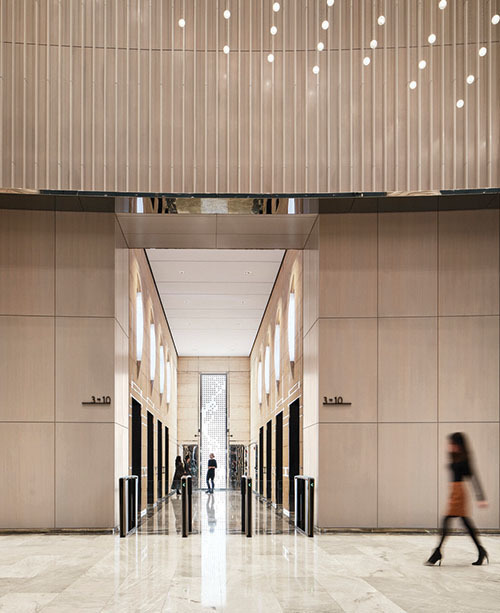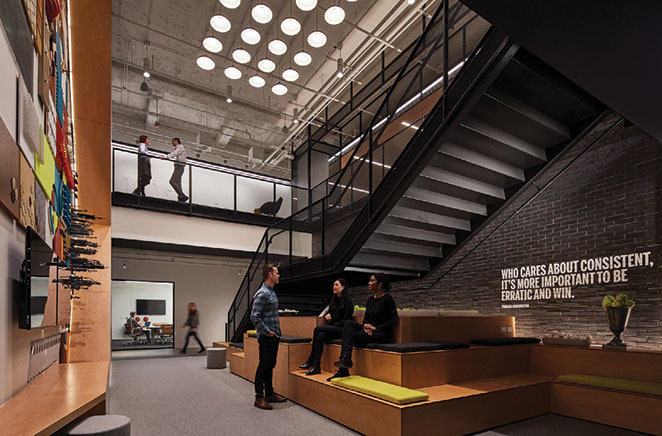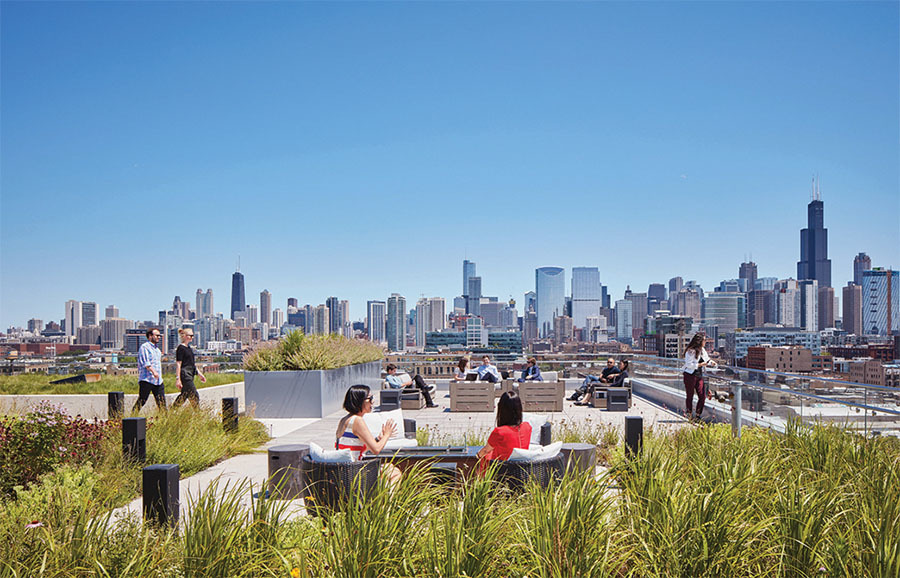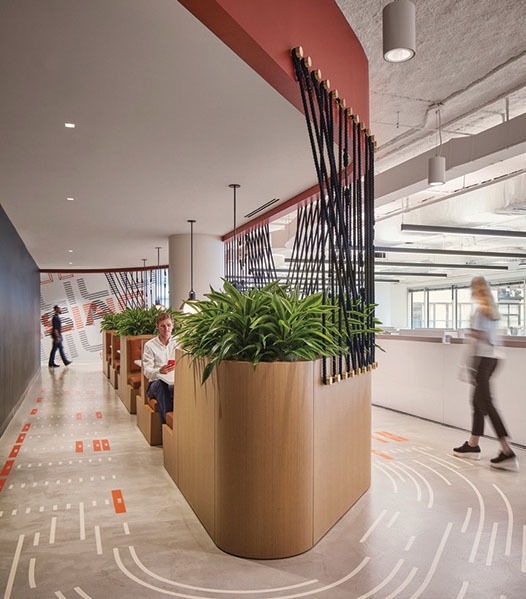"The office is dead," according to the hyperbolic headlines and attention-grabbing Zoom webinar titles that have filled our inboxes and news feeds since earlier this spring.
And, while many workers might have enjoyed the extra time at home initially, the truth of the matter has emerged following the initial shock: The workplace is undergoing change, yes, but its relevance and centrality to the success of an organization remains.
Conducted during the early weeks of the pandemic, Gensler’s 2020 Work From Home (WFH) Survey of 2,300 U.S. workers found that, pre-COVID, just one in 10 U.S. office workers worked from home regularly, and less than one-third were offered the choice to work from home by their employer.
The data also supports the notion that people are eager to return to the workplace: 77 percent of Gensler WFH Survey respondents want to be back to the office three or more days per week, with 44 percent of those preferring all five days in the office.
Just six months out from this survey, it is clear that "work" and "place" have become uncoupled. Though there were signs pre-pandemic that this shift was coming, the ongoing health crisis and extended time in the home office have accelerated the necessity for companies to adopt new approaches to enabling work. These new approaches not only can enhance creativity and productivity, but can make people feel more comfortable coming back to the office. And, these changes give us the opportunity to address shortcomings that had begun to emerge previously in our places of work—over-densification; static, inflexible spaces; and poor deployment of technology among them.
There is no shortage of debate, opinion and study around what will have staying power following the pandemic. And, while no one can definitively predict the final outcomes, we can begin to carve a path forward by centering the current mindset of workers.
So, what role should office buildings play in supporting workers as they return, and what can they offer that will motivate workers to consistently choose to utilize the building in a new era of freedom and mobility? Properties with the right answers to these questions will emerge as unique and sought-after real estate assets to both owners and tenants; their long-term values will positively impact real estate portfolios and human capital.
Survey results, conversations with clients, and in-process design and strategy projects together reveal two overarching categories of worker expectations. First, they expect safety and well-being to be at the forefront in order to begin their return to the office. And, second, to get them to keep coming back, they expect their buildings to support and engage them in an environment that enables their time there to be more productive, connected and purposeful.
"Support my need for physical, emotional and health security at work."

The events of September 11 set the stage for today’s expectations when it comes to building security. Buildings took extensive, though ultimately short-term, measures that softened over time, but set a new standard in the long term for security. The pandemic presents a similar situation: Buildings are overcorrecting somewhat in the short term to ensure people feel comfortable entrusting them with their well-being, though it will create lasting change in tenants’ understanding of security even after the pandemic subsides.
To address workers’ concerns around all facets of security, owners and managers should consider the following factors:
- Offer a transparent, tech-enabled welcome. Building lobbies will evolve from places that accommodate reception and security into harder-working spaces that engage both the building and its surrounding community to bring a feeling of safety to tenants. The implementation of more passive security systems, such as facial recognition or mobile technologies, will enable a reimagination of the security and reception experience. Digital elements will be leveraged beyond "eye candy" and integrate more meaningfully, becoming functional concierges and communication components that process guests and deliver live building data on air quality, energy use and building programming.
- Maintain autonomy and choice. At home, workers have become accustomed to moving from their desk to the kitchen table to the couch and back as they navigate virtual meetings, manage their comfort and take moments for rest or to engage with family. Offering similar levels of choice and flexibility in the building will allow people to continue to self-manage based on desired distances, noise levels, postures and other preferences. Access to outdoor space is expected, and the more option-rich, the better. Outdoor meeting spaces, quiet areas and socialization hot spots bring variety to the experience of getting some fresh air.
- Create order and clarity. Mobile devices will be leveraged to activate and gain access to the building, vertical transportation systems and tenant spaces, providing workers with defined paths to safely navigate. And, the opportunity for digital platforms to support the office experience will proliferate far beyond wayfinding, from low-contact arrival, guest access, personal convenience and selecting the spaces and experiences needed to support the work happening that day.
- Listen and adapt. Tenants and workers recognize that initial steps forward in this situation are, in many ways, an experiment. Successful buildings will embrace iteration and continuous improvement, which require a mechanism for feedback and a transparent process for communicating what is being done to address that feedback. Knowing that one is being listened to is powerful; it can shift their feelings of insecurity toward those of empowerment, alignment and safety.
"Engage me with an environment that allows me to work better."

If we ask workers how they’re doing working from home, some will say that focused work comes more easily away from the office. But, as the survey results underscore, they’ll also report that they miss the office’s ability to encourage building rapport and community; reinforce culture and impromptu interaction; and inspire a sense of purpose.
Many tenant spaces, borrowing from square footage previously dedicated purely to desking, already are being reimagined to make room for flexible collaborative spaces to support workers who have a renewed sense of what they most want when they come into the office. Buildings must be supportive, and, in fact, act as true partners in fostering this level of adaptability and in offering solutions that support what is now a baseline worker expectation: that office environments are more than containers—they are incubators of ideas and champions of connection.
Ways in which to reimagine spaces include the following:
- Encourage the unplanned and informal. Research shows that much of the on-the-job learning workers experience happens by osmosis; thousands of informal moments and interactions that, over time, add up to years of experience and a wealth of knowledge. It turns out that conversations over the coffee maker—those casual collisions that happen all day in the office—are so often where mentor/mentee relationships are born, details are hashed out and solutions are realized. Workers are missing the unplanned moments that ultimately drive their projects, ideas and careers forward, and they expect to return to spaces that create opportunities for connection.
- Support a mixed reality. The pandemic has opened even the most traditionally minded companies to offer more mobility for employees. This forced experiment has led to revelations within organizations, especially those that hadn’t yet responded to workers’ desires for increased flexibility. This new blended way many will work—partially at home, partially in the office—requires spaces and technology to support it. Hybrid spaces will be on the rise, and single-use spaces will fall away in favor of environments that can easily flex to take on new functions. There will be more of a need to meaningfully capture presence through technology and video capabilities, including collaboration tools that allow for contribution to content development and inch us toward more impromptu virtual connections.
As individual expectations of flexibility ladder up to the organizational level, tenants need the building’s support in embracing the unknown. We know that companies will need to reduce and increase their footprints more fluidly. They might adopt new forms of agile working that will result in alternative real estate utilization strategies. Building ownership can support this expected fluidity by offering flexible space types and lease terms, where a tenant can commit to the building while also flexing, as needed, to meet shifting needs over the course of their commitments.
- Keep it fresh. There will be a need to maintain workers’ interest and desire to continue to leverage places of work when working from home continues to be a viable option. Pop-ups, rotating offerings and calendared programming will spark discovery and enhance work experiences, especially for those who have experienced a very prescribed routine while away from the office.
- Make it easy. The next generation of building technologies makes interactions even more seamless, so people can focus on work and not on a full wastebasket or lost office key. Automated entry systems via sensors and powered door operators get workers where they’re going quickly, while also mitigating issues of cleanliness and maintaining a connection to security monitoring systems. Entries, elevators, lights, shade devices, restrooms, air systems, waste bins and more can be enabled to identify needs via sensors before people realize they have them or can be activated with a wave of a hand. And, on a broader scale, these more robust building automation systems can create a live feedback loop of user experience, traffic and usage data, helping buildings and tenants achieve operational optimization and open opportunities for enhanced spatial utilization.

- Enable "real life." Workers’ choices to return to the office will bring with it the expectation that their work and personal lives can seamlessly converge, offering convenience, efficiency and balance. Package management and storage spaces will shift to meet the needs of the building users, as increases in the volume of items being delivered and subsequently stored point to new security, communication and processing accommodations. Physical space for lockers and improved digital communication strategies will be the first components to meet these needs, and, in the near future as emerging automated delivery systems become more prevalent, drone or cyberphysical accommodations will need to be met with landing pads and building access systems.

Tomorrow’s successful office buildings will ultimately reinforce an emphasis on real estate performance while balancing personal security, well-being, purpose and presence at the individual level. While the path to this future is uncharted, we are not without a North Star. We can look to recent trends in office building design and operations, understanding that those same needs exist; they’ve just become accelerated, heightened and intensified to respond to the gravity of this moment.
About the authors:
Eric Gannon is principal + regional workplace leader, and Brian Hungerford is senior associate + regional office buildings leader, both with Gensler.
This article was originally published in the September/October 2020 issue of BOMA Magazine.